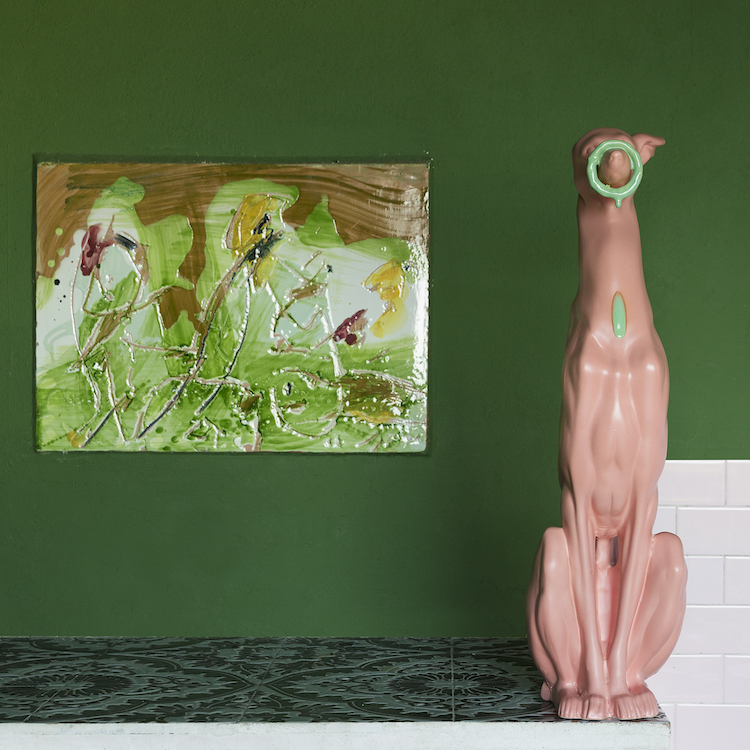Yes, I am back after a three month sabbatical. It did not dull my teeth. Indeed they are sharper for taking a back seat. Yes, mixed metaphors, but so be it.


Installation view of The Body, The Mind, This Constructed World exhibition by Anders Herwald Ruhwald at Casa Museo Asger Jorn, Albissola Marina.
Officine Saffi and the Jorn House Museum are showing The Body, The Mind, This Constructed World, a solo exhibition by Anders Herwald Ruhwald. The exhibition will be open from 17 July to 30 September at the Jorn House Museum, Albissola Marina. Together with the Milanese preview, The Thing in Your Mind ––organised by Officine Saffi in April 2018, the exhibition in Albissola represents the first solo museum exhibition in Italy by the Danish artist currently residing in the United States.
The Body, The Mind, This Constructed World is an entirely new body of work made by Ruhwald specifically for the Jorn House Museum. According to the Musuem the fifteen sculptures, installed in and around the buildings and gardens of the museum, are the result of a year of Ruhwald’s dedicated research into Asger Jorn’s writings and theories on architecture and design. Ruhwald’s individual sculptures become annotations to the house and recontextualize central ideas of Asger Jorn’s universe and theoretical framework––especially his critique of functionalism, capitalism and his use of décollage as an artistic strategy. To explain further:
“In this way Ruhwald’s interventions at the Jorn House Museum serve as questions and commentary to Jorn’s architecture in the form of sculptures. These sculptures occupy specific sites in the museum- not trying to inhabit it, but by engaging a house that once was a living artwork but now is a museum. As an example the two sculptures Adaptable Body I e II are attached to the kitchen furniture by commercial clamps from which amorphous glazed lumps of ceramics protrude.
These sculptures integrate the furniture into the sculpture by reconfiguring the utilitarian value of the furniture. Yet this relationship is not fixed and is potentially changeable by releasing the clamp and placing the object elsewhere. Hereby the sculptures are a temporary animation of an otherwise set interior, rearranging the objects hierarchies of room. It is a potentially continual changing type of sculpture that can make the any object it attaches to part of its meaning.
Around the gardens four bust-like ceramic heads titled The Four Sailors are placed. Each sculpture highlights a specific feature of the human head- an ear, an eye, a month, a nose- but are otherwise without specific facial characteristics. By this The Four Sailors are traditional busts that emphasize a human sensory ability in lieu of any kind of classical portraiture. As such they are a depiction of a fractured human perceptual ability and become a problematic allusion to Jorn’s theories of man in culture and nature”.

Does Ruhwald’s exhibition really query Jorn’s architectural critique and vision, as it is manifested at the Jorn House Museum? Does it ask the question of how a place conceived and understood as a radical form of ever evolving architecture can progress after its creators have passed?
In Ruhwald’s mind, probably. In the museum it fails totally. The work does not, without text heavy footnotes, do anything the museum claims. Certainly the work does not appear as a critique any viewer could comprehend. It is just business as usual for a gifted sculptor.
Moreover his art is often lost in Jorn’s crazy setting, it fails to co-opt the environment, due to a scale that is too minor for the task at hand. I know the Jorn house and find the works with the exception of the nutty pink cat, to lack any connective tissue.
Once we ditch the thesis, Ruhwald’s work provides some poetic context to that of Jorn particularly in the room with a brown seemingly-figurative sculpture and a high mural by Jorn.

Ruhwald is great at installations and the museum has wisely provided us with a few examples to make the point and they are shown below. A better example would be the inhabiting of the Saarinen House where real chemistry was achieved in dealing with father and son tensions though even this only worked with pre-knowledge.
Artists need to be cautious when they take on the homage business. Can they do something visually unique that transforms their subject or do they end up being pretentious art critics? This show claims too much and delivers too little. Still, the work, unplugged from conceptual blather, often succeeds on its own.




The exhibition, curated by the artistic director of the Jorn House Museum, Luca Bochicchio, has been produced by Officine Saffi with the support of the OJD Foundation and the Danish Arts Foundation, the patronage of the Municipality of Albissola Marina, and the contribution of the Amici di Casa Jorn (Friends of Casa Jorn) Association.
Love or loath this exhibition from the world of contemporary ceramic art and contemporary ceramics? Share your thoughts in the comments section below.

Installation view. You in Between, Middlesborough Institute of Modern Art, UK, 2008

Installation view. The Hand is the Mind is the Bomb that Blows, Moran Moran Gallery, Los Angeles, USA, 2017

Installation View, Like the new past, Denver Art Museum, USA, 2011

Installation View, You will see, Lemberg Gallery, USA, 2011

Installation view. You in Between, Middlesborough Institute of Modern Art, UK, 2008

This was refreshing to read how many times are we just reading rehashed press releases thank you.
Actually many of the better galleries are hiring real writers and they can be scholarly and revealing.